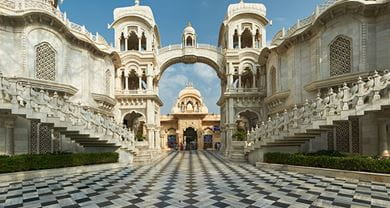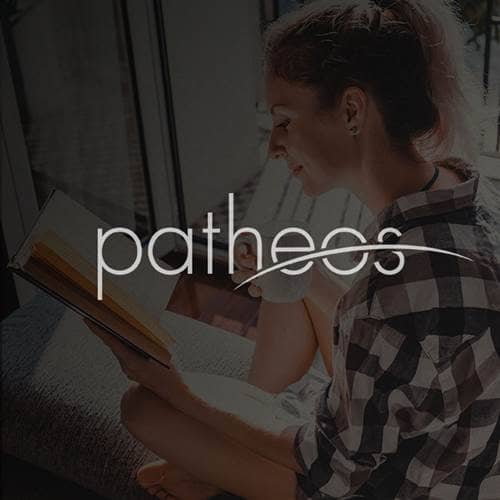- Trending:
- Pope Leo Xiv
- |
- Israel
- |
- Trump
- |
- Social Justice
- |
- Peace
- |
- Love

RELIGION LIBRARY
ISKCON (Hare Krishna)
Sacred Narratives
The sacred narrative of ISKCON is best encapsulated in the name of the movement's official magazine: Back to Godhead. Hare Krishna devotees believe that Krishna created all life, and that human beings innately desire to return to Krishna, to return to God. ISKCON members believe that the world's religions all attempt to do this, but they maintain that their own Vaishnava tradition offers the best method to do so, since only it teaches the supreme personality of God.
In keeping with its origin within Hinduism, the Hare Krishna movement accepts the general contours of Hinduism's sacred narrative. Like the broader tradition, ISKCON understands the universe as created and destroyed over infinite cyclical of vast cosmic time, called yugas. The present age is that of Kali Yuga, the era of degeneration that marks the end of the current cycle of the cosmos. During this time the human species and human civilization have devolved to such an extent that fewer options exist to return to Godhead. During this age, Hare Krishna devotees believe, the best option is that of devotional service (bhakti) to God, particularly in his true supreme form as Krishna.
ISKCON understands itself as a Vedic movement, in that it places the ancient Indian corpus known as the Vedas at the center of its sacred narrative. Hare Krishna devotees take a slightly broader view of the contents of the Vedic canon than do many other Hindus, including both the Bhagavadgita and Bhagavata Purana as Vedic. Hare Krishnas believe that the Vedas exist in order to help human beings understand the material and spiritual world, to learn about the nature of God, and to discover how to return to Godhead. As such, the Vedas not only contain the sacred narratives of ISKCON, they are part of the sacred narrative itself.
ISKCON holds that Krishna revealed the Vedas to a series of ancient sages (rishis) hundreds of millions of years ago, who then recorded them in the form of the Vedas. Though ISKCON does not consider the Vedas to be word-for-word revelations, it does consider the texts absolutely true and derived from the divine. Devotees focus on the stories and teachings that involve Krishna, or in the case of the earlier Vedic material, Vishnu.
The most important narratives within ISKCON's religious worldview are those found in the Bhagavadgita and Bhagavata Purana. While scholars ascribe a post-Vedic dating for these texts, the texts themselves claim to be ancient, and on this evidence ISKCON has considered both to be Vedic as well. The Bhagavadgita, part of a much longer tale called the Mahabharata, narrates the story of Krishna and his friend and disciple Arjuna. For Hare Krishna devotees it models the manner in which the human being (Arjuna in the text) takes Krishna as his guru and learns transcendental truths from him. Though ISKCON devotees take human beings as their gurus, they understand Arjuna as the originator of the broader Vaishnava sampradaya (lineage of teachers), making Krishna himself the founder of their lineage.
The Bhagavata Purana, often called the Bhagavatam by Hare Krishna devotees, details the earthly pastimes of Krishna, and as such is a source of multiple sacred narratives. Most of the text focuses on the various avatars, or earthly incarnations, that Krishna has taken. (For other Hindus, the text describes the avatars of Vishnu. Only Gaudiya Vaishnavas understand Krishna as the true nature of Vishnu.) These include numerous different avatar forms as described in the Puranas, ranging from cosmic animals such as Varaha, a boar who lifted the earth out of the sea, to quasi-mythic figures, such as Narasimha, a man-lion, to historical personages, such as the Buddha. Most ISKCON devotees read these stories as entirely literal and accurate depictions of past events, though some Hare Krishnas accept more symbolic readings of some of these sacred narratives.
Of the many important narratives found in the Bhagavata Purana, the most central for actual ISKCON practice and belief are those that detail the pastimes (lila) of Krishna during the period in which he took an avatar using his own personality and name. Devotees particularly look to the narratives about his youth spent in the land of Vrindavan as a prince. One story describes Krishna stealing butter from his mother, an episode often read as a metaphor for God's mischievous love for humanity. Another set of tales describes Krishna's amorous activities with the gopis, the female cowherds, who abandon their posts and sometimes their husbands to frolic with Krishna in the fields. Most ISKCON devotees read this narrative as a symbol of the intimate relationship that Krishna seeks with his devotees.
Owing to its origin in Hinduism, numerous other sacred narratives exist within ISKCON. Those that involve Krishna, Vishnu, or one of the other Vishnu avatars are most central. The narrative of the Ramayana offers one example. This epic describes the saga of the King Rama's quest to rescue his wife Sita from a demon king. ISKCON, like Hinduism more broadly, understands Rama as an avatar of the divine, and in their particular case, Hare Krishna devotees look to Rama as a form of Krishna. ISKCON accepts the Hindu sacred narratives describing other deities, such as Shiva or Ganesha, but subordinates them to those of Krishna/Vishnu.
Study Questions:
1. What is ISKCON's sacred narrative?
2. What are the implications of living within the Kali Yuga?
3. How are the Vedas used by ISKCON members?
4. Why are the Bhagavadgita and the Bhagavata Purana considered to be the most important sacred narratives?










